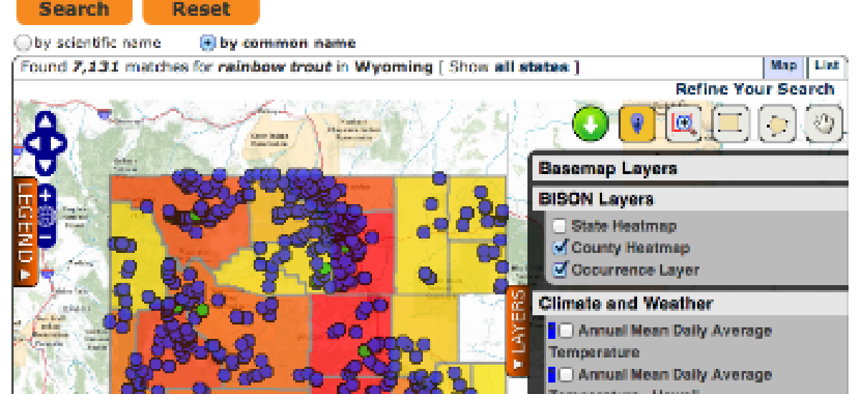USGS's new database helps users map biodiversity

A new web site opens up more than 100 million mapped records of nearly every living species nationwide.

A new Web-based federal resource makes more than 100 million mapped records of nearly every living species nationwide searchable by any user.
The Biodiversity Information Serving Our Nation (BISON) system allows users -- often land managers, researchers, refuge managers, citizen scientists, agriculture professionals, fisheries managers, water resource managers, educators and others -- to search for hundreds of thousands of species records in search fields ranging from the entire country and U.S. territories down to specific towns or parks.
BISON displays search results in list or interactive map formats, and each species occurrence point can be clicked on to find more information about who provided or collected the data. Ultimately, more than 50 layers of environmental information can be visualized in each search result, making the data easier to understand.
The U.S. Geological Survey “is proud to announce this monumental resource,” said Kevin Gallagher, associate director of USGS’ Core Science Systems, in a press statement.
“This is a testament to the power of combining the efforts of hundreds of thousands of professional and citizen scientists into a resource that uses big-data and open-data principles to deliver biodiversity information for sustaining the nation’s environmental capital,” Gallagher added.
BISON was built by the USGS and will be maintained on the Energy Department’s computing infrastructure at Oak Ridge National Laboratory in Tennessee.
Users can query species by scientific or common name, year range, state, county, basis of record or provider institution. And searches are not limited to living species. A search for Tyrannosaurus rex -- the dinosaur that died out 65 million years ago -- returns results showing where T. rex fossil remains have been found across the country.
One example of a practical use of BISON would be a land manager looking for land to purchase for conservation. BISON makes it easy to search for all documented species on a parcel and helps conservationists make more informed decisions.
BISON already includes millions of data points from the federal investment in biodiversity research, and it stands to increase the size of its database and its delivery of federally funded biodiversity data through formal cooperation with other agencies.
The undertaking already includes participation from hundreds of thousands of citizen and professional scientists. Nongovernmental organizations, state and local governments, universities, and many others are also participating in the enormous undertaking.
"With BISON, the USGS takes a big step toward making biodiversity data held within federal agencies easier to find and use,” said Mary Klein, president of NatureServe, a nonprofit organization whose mission is to provide the scientific basis for effective conservation action.
“I am enthusiastic about future opportunities to work with USGS to increase collaboration among federal, state and private data holders,” Klein added.



